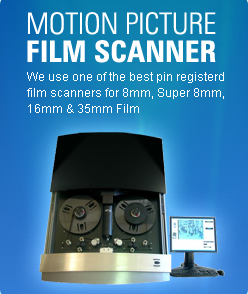
Film Conversion Equipment
Film Scanning and Film Transfer Equipment Types
The type of film scanning machine used for your 8mm, Super 8 or 16mm film conversion will have as much of an impact on the quality you receive as the resolution of the scan itself will. For example, if you wanted to digitize a photograph and tried doing it two different ways. You first put the photograph down on a table and took a picture of it using your smart phone or camera. Then you took the picture and scanned it using a flatbed scanner. If you compare the two side by side on your computer it will become really obvious that the flatbed scanner produced a digital image as good as the photograph. However, the picture you took with your phone or camera does not look close to the quality of the original photograph.
The same goes for scanning your 8mm, Super 8 or 16mm film. The real-time and frame by frame machines below are using a camcorder to take a picture of your film. The motion picture film scanner and Datacine machine are scanning the film. The results will be significantly different.
Film Conversion Equipment |
|
Real Time
|
|
Frame by Frame
|
|
Professional Film Scanners
|
|
Equally important as resolution is the type of film transfer. There are a few basic types of film transfer processes. More than 80% of the companies out there today use a real-time transfer. Any type of real-time film transfer will result in video that is 40-50% worse than the film’s current condition.
Anchorage Fun Facts: The largest city in the state, Anchorage encompasses an area of nearly 2,000 square miles, about the size of the state of Delaware. The city sits on a triangular peninsula surrounded by the Cook Inlet, which is the northernmost reach of the Pacific Ocean. The Chugach, Kenai, Talkeetna, Tordrillo, Aleutian and Alaska mountain ranges are all visible from the city, and on clear days so is Mount McKinley, North America's tallest mountain, which is located 130 miles north of Anchorage. Roughly twice the size of Rhode Island, Anchorage encompasses an area of nearly 2,000 square miles.
Alaska Fun Facts: Secretary of State William Seward, who arranged to purchase the land from Russia. Critics of the purchase believed that the land had nothing to offer, but the discovery of gold in the 1890s created a stampede of prospectors and settlers. Alaska is bounded by the Beaufort Sea and the Arctic Ocean to the north; Canada’s Yukon Territory and British Columbia province to the east; the Gulf of Alaska and the Pacific Ocean to the south; the Bering Strait and the Bering Sea to the west; and the Chukchi Sea to the northwest. The capital is Juneau.








